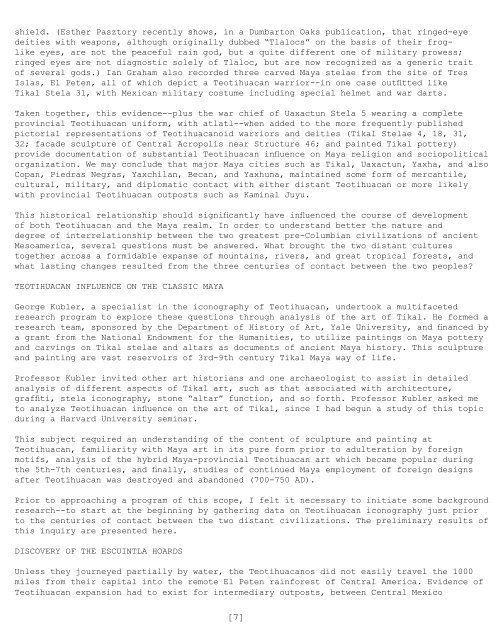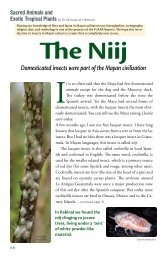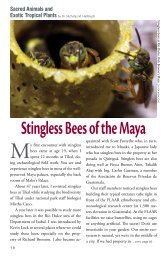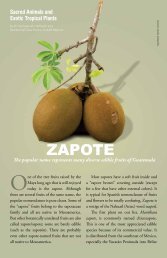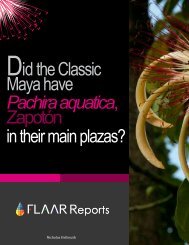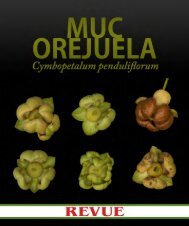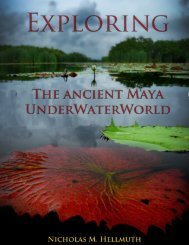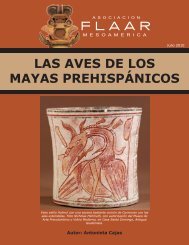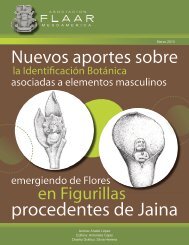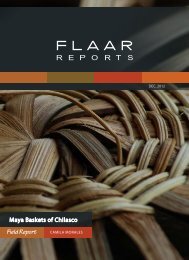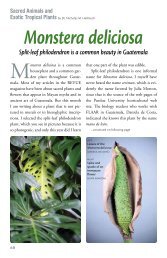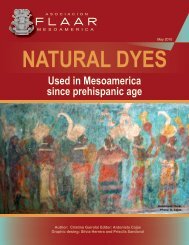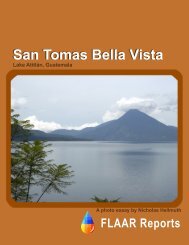The Escuintla Hoards Teotihuacan Art in Guatemala
The Escuintla Hoards Teotihuacan Art in Guatemala
The Escuintla Hoards Teotihuacan Art in Guatemala
You also want an ePaper? Increase the reach of your titles
YUMPU automatically turns print PDFs into web optimized ePapers that Google loves.
shield. (Esther Pasztory recently shows, <strong>in</strong> a Dumbarton Oaks publication, that r<strong>in</strong>ged-eye<br />
deities with weapons, although orig<strong>in</strong>ally dubbed “Tlalocs” on the basis of their froglike<br />
eyes, are not the peaceful ra<strong>in</strong> god, but a quite different one of military prowess;<br />
r<strong>in</strong>ged eyes are not diagnostic solely of Tlaloc, but are now recognized as a generic trait<br />
of several gods.) Ian Graham also recorded three carved Maya stelae from the site of Tres<br />
Islas, El Peten, all of which depict a <strong>Teotihuacan</strong> warrior--<strong>in</strong> one case outfitted like<br />
Tikal Stela 31, with Mexican military costume <strong>in</strong>clud<strong>in</strong>g special helmet and war darts.<br />
Taken together, this evidence--plus the war chief of Uaxactun Stela 5 wear<strong>in</strong>g a complete<br />
prov<strong>in</strong>cial <strong>Teotihuacan</strong> uniform, with atlatl--when added to the more frequently published<br />
pictorial representations of <strong>Teotihuacan</strong>oid warriors and deities (Tikal Stelae 4, 18, 31,<br />
32; facade sculpture of Central Acropolis near Structure 46; and pa<strong>in</strong>ted Tikal pottery)<br />
provide documentation of substantial <strong>Teotihuacan</strong> <strong>in</strong>fluence on Maya religion and sociopolitical<br />
organization. We may conclude that major Maya cities such as Tikal, Uaxactun, Yaxha, and also<br />
Copan, Piedras Negras, Yaxchilan, Becan, and Yaxhuna, ma<strong>in</strong>ta<strong>in</strong>ed some form of mercantile,<br />
cultural, military, and diplomatic contact with either distant <strong>Teotihuacan</strong> or more likely<br />
with prov<strong>in</strong>cial <strong>Teotihuacan</strong> outposts such as Kam<strong>in</strong>al Juyu.<br />
This historical relationship should significantly have <strong>in</strong>fluenced the course of development<br />
of both <strong>Teotihuacan</strong> and the Maya realm. In order to understand better the nature and<br />
degree of <strong>in</strong>terrelationship between the two greatest pre-Columbian civilizations of ancient<br />
Mesoamerica, several questions must be answered. What brought the two distant cultures<br />
together across a formidable expanse of mounta<strong>in</strong>s, rivers, and great tropical forests, and<br />
what last<strong>in</strong>g changes resulted from the three centuries of contact between the two peoples?<br />
TEOTIHUACAN INFLUENCE ON THE CLASSIC MAYA<br />
George Kubler, a specialist <strong>in</strong> the iconography of <strong>Teotihuacan</strong>, undertook a multifaceted<br />
research program to explore these questions through analysis of the art of Tikal. He formed a<br />
research team, sponsored by the Department of History of <strong>Art</strong>, Yale University, and f<strong>in</strong>anced by<br />
a grant from the National Endowment for the Humanities, to utilize pa<strong>in</strong>t<strong>in</strong>gs on Maya pottery<br />
and carv<strong>in</strong>gs on Tikal stelae and altars as documents of ancient Maya history. This sculpture<br />
and pa<strong>in</strong>t<strong>in</strong>g are vast reservoirs of 3rd-9th century Tikal Maya way of life.<br />
Professor Kubler <strong>in</strong>vited other art historians and one archaeologist to assist <strong>in</strong> detailed<br />
analysis of different aspects of Tikal art, such as that associated with architecture,<br />
graffiti, stela iconography, stone “altar” function, and so forth. Professor Kubler asked me<br />
to analyze <strong>Teotihuacan</strong> <strong>in</strong>fluence on the art of Tikal, s<strong>in</strong>ce I had begun a study of this topic<br />
dur<strong>in</strong>g a Harvard University sem<strong>in</strong>ar.<br />
This subject required an understand<strong>in</strong>g of the content of sculpture and pa<strong>in</strong>t<strong>in</strong>g at<br />
<strong>Teotihuacan</strong>, familiarity with Maya art <strong>in</strong> its pure form prior to adulteration by foreign<br />
motifs, analysis of the hybrid Maya-prov<strong>in</strong>cial <strong>Teotihuacan</strong> art which became popular dur<strong>in</strong>g<br />
the 5th-7th centuries, and f<strong>in</strong>ally, studies of cont<strong>in</strong>ued Maya employment of foreign designs<br />
after <strong>Teotihuacan</strong> was destroyed and abandoned (700-750 AD).<br />
Prior to approach<strong>in</strong>g a program of this scope, I felt it necessary to <strong>in</strong>itiate some background<br />
research--to start at the beg<strong>in</strong>n<strong>in</strong>g by gather<strong>in</strong>g data on <strong>Teotihuacan</strong> iconography just prior<br />
to the centuries of contact between the two distant civilizations. <strong>The</strong> prelim<strong>in</strong>ary results of<br />
this <strong>in</strong>quiry are presented here.<br />
DISCOVERY OF THE ESCUINTLA HOARDS<br />
Unless they journeyed partially by water, the <strong>Teotihuacan</strong>os did not easily travel the 1000<br />
miles from their capital <strong>in</strong>to the remote El Peten ra<strong>in</strong>forest of Central America. Evidence of<br />
<strong>Teotihuacan</strong> expansion had to exist for <strong>in</strong>termediary outposts, between Central Mexico<br />
[7]


